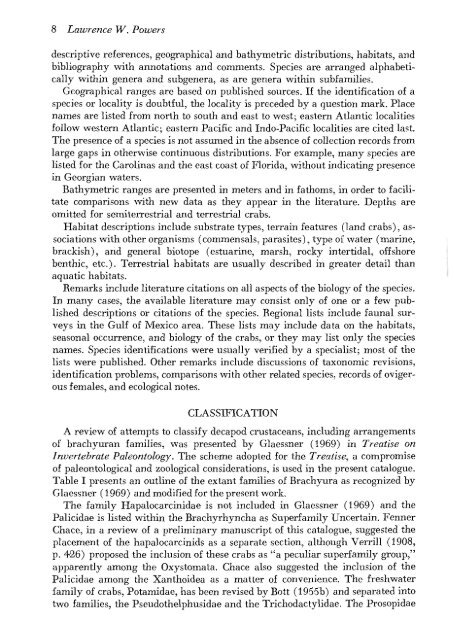Create successful ePaper yourself
Turn your PDF publications into a flip-book with our unique Google optimized e-Paper software.
8 Lawrence W. Powers<br />
descriptive references, geographical and bathymetric distributions, habitats, and<br />
bibliography with annotations and comments. Species are arranged alphabetically<br />
vi^ithin genera and subgenera, as are genera within subfamilies.<br />
Geographical ranges are based on published sources. If the identification of a<br />
species or locality is doubtful, the localitj^ is preceded by a question mark. Place<br />
names are listed from north to south and east to west; eastern Atlantic localities<br />
follow western Atlantic; eastern Pacific and Indo-Pacific localities are cited last.<br />
The presence of a species is not assumed in the absence of collection records from<br />
large gaps in otherwise continuous distributions. For example, many species are<br />
listed for the Carolinas and the east coast of Florida, without indicating presence<br />
in Georgian waters.<br />
Bathymetric ranges are presented in meters and in fathoms, in order to facilitate<br />
comparisons wth new data as they appear in the literature. Depths are<br />
omitted for semiterrestrial and terrestrial crabs.<br />
Habitat descriptions include substrate types, terrain features (land crabs), associations<br />
with other organisms (commensals, parasites), type of water (marine,<br />
brackish), and general biotope (estuarine, marsh, rocky intertidal, offshore<br />
benthic, etc.). Terrestrial habitats are usually described in greater detail than<br />
aquatic habitats.<br />
Remarks include literature citations on all aspects of the biolog}^ of the species.<br />
In many cases, the available literatvire may consist only of one or a few published<br />
descriptions or citations of the species. Regional lists include faunal surveys<br />
in the Gulf of Mexico area. These lists may include data on the habitats,<br />
seasonal occurrence, and biology of the crabs, or they may list only the species<br />
names. Species identifications were usually verified by a specialist; most of the<br />
lists were published. Other remarks include discussions of taxonomic revisions,<br />
identification problems, comparisons with other related species, records of ovigerous<br />
females, and ecological notes.<br />
CLASSIFICATION<br />
A review of attempts to classify decapod crustaceans, including arrangements<br />
of brachyuran families, was presented by Glaessner (1969) in Treatise on<br />
Invertebrate Paleontology. The scheme adopted for the Treatise, a compromise<br />
of paleontological and zoological considerations, is used in the present catalogue.<br />
Table I presents an outline of the extant families of Brachyura as recognized by<br />
Glaessner (1969) and modified for the present work.<br />
The family Hapalocarcinidae is not included in Glaessner (1969) and the<br />
Palicidae is listed within the Brachyrhyncha as Superfamily Uncertain. Fenner<br />
Chace, in a review of a preliminary'- manuscript of this catalogue, suggested the<br />
placement of the hapalocarcinids as a separate section, although Verrill (1908,<br />
p. 426) proposed the inclusion of these crabs as "a peculiar superfamily group,"<br />
apparently among the Oxystomata. Chace also suggested the inclusion of the<br />
Palicidae among the Xanthoidea as a matter of convenience. The freshwater<br />
family of crabs, Potamidae, has been revised by Bott (1955b) and separated into<br />
two families, the Pseudothelphusidae and the Trichodactylidae. The Prosopidae

















